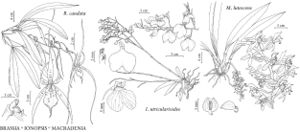Difference between revisions of "Tolumnia bahamensis"
Orchidee (Hamburg) 37: 59. 1986.
FNA>Volume Importer |
FNA>Volume Importer |
||
| Line 14: | Line 14: | ||
|name=Oncidium variegatum | |name=Oncidium variegatum | ||
|authority=(Swartz) Swartz | |authority=(Swartz) Swartz | ||
| − | }}{{Treatment/ID/Synonym | + | }} {{Treatment/ID/Synonym |
|name=Oncidium variegatum subsp. bahamense | |name=Oncidium variegatum subsp. bahamense | ||
|authority=(Nash ex Britton & Millspaugh) Withner | |authority=(Nash ex Britton & Millspaugh) Withner | ||
| Line 32: | Line 32: | ||
|elevation=0–10 m | |elevation=0–10 m | ||
|distribution=Fla.;West Indies (Bahamas). | |distribution=Fla.;West Indies (Bahamas). | ||
| − | |discussion=<p>Tolumnia bahamensis has been regarded by some authors as a synonym or variety of T. variegata (D. S. Correll 1950; C. L. Withner 1980). Flower morphology helps little in the T. variegata complex (J. D. Ackerman and M. Galarza-Pérez 1991); T. bahamensis differs, however, by being a tetraploid (84 chromosomes) and having semiterete leaves. These features also exist in T. sylvestris (G. J. Braem 1986b), a species of eastern Cuba generally found in high elevation pine forests, a habitat somewhat different from that of either Florida or the Bahamas. Whether or not T. sylvestris and T. bahamensis are conspecific awaits further studies.</p> | + | |discussion=<p><i>Tolumnia bahamensis</i> has been regarded by some authors as a synonym or variety of T. variegata (D. S. Correll 1950; C. L. Withner 1980). Flower morphology helps little in the T. variegata complex (J. D. Ackerman and M. Galarza-Pérez 1991); <i>T. bahamensis</i> differs, however, by being a tetraploid (84 chromosomes) and having semiterete leaves. These features also exist in <i>T. sylvestris</i> (G. J. Braem 1986b), a species of eastern Cuba generally found in high elevation pine forests, a habitat somewhat different from that of either Florida or the Bahamas. Whether or not <i>T. sylvestris</i> and <i>T. bahamensis</i> are conspecific awaits further studies.</p> |
|tables= | |tables= | ||
|references= | |references= | ||
| Line 56: | Line 56: | ||
|publication year=1986 | |publication year=1986 | ||
|special status= | |special status= | ||
| − | |source xml=https://jpend@bitbucket.org/aafc-mbb/fna-data-curation.git/src/ | + | |source xml=https://jpend@bitbucket.org/aafc-mbb/fna-data-curation.git/src/8f726806613d60c220dc4493de13607dd3150896/coarse_grained_fna_xml/V26/V26_1338.xml |
|subfamily=Orchidaceae subfam. Epidendroideae | |subfamily=Orchidaceae subfam. Epidendroideae | ||
|tribe=Orchidaceae tribe Maxillarieae | |tribe=Orchidaceae tribe Maxillarieae | ||
Revision as of 16:42, 18 September 2019
Plants to 12 cm (excluding inflorescence). Leaves semiterete 3–10 × 0.4–1 cm. Inflorescences 1–4, erect, to 50 cm, side branches few or none, to 4.5 cm; bracts 2–6 mm. Flowers white with red-brown spots at bases of perianth parts; sepals spatulate, 4–6 × 1–2 mm, apex apiculate; lateral sepals connate to 3/4 length; petals spatulate to pandurate, 5 × 2 mm, apex rounded to retuse, often apiculate; lip with large red-brown spots near yellow callus, 8–12 × 8–13 mm, middle lobe about 1/3 wider than combined lateral lobes, apex retuse-apiculate, isthmus 0.2–0.4 cm wide with serrate margins; callus with 2 sets of tuberculate processes, 3 proximal, broader, 2 distal, smaller; column whitish to pale lavender with yellow base and white to rose-purple column wings 5–6 mm. Capsules 1.5 cm.
Phenology: Flowering Apr–Jun.
Habitat: Terrestrial or epiphytic on shrubs and scrub trees in dry thickets
Elevation: 0–10 m
Distribution
Fla., West Indies (Bahamas).
Discussion
Tolumnia bahamensis has been regarded by some authors as a synonym or variety of T. variegata (D. S. Correll 1950; C. L. Withner 1980). Flower morphology helps little in the T. variegata complex (J. D. Ackerman and M. Galarza-Pérez 1991); T. bahamensis differs, however, by being a tetraploid (84 chromosomes) and having semiterete leaves. These features also exist in T. sylvestris (G. J. Braem 1986b), a species of eastern Cuba generally found in high elevation pine forests, a habitat somewhat different from that of either Florida or the Bahamas. Whether or not T. sylvestris and T. bahamensis are conspecific awaits further studies.
Selected References
None.
